RAID arrays can present some of the most complex problems in data recovery and you should choose your raid data recovery company carefully. THE most important thing is finding a RAID specialist in your local area, as opposed to ‘Drop Off’ locations where your drives are shipped out of state. Having a failed RAID is devastating enough, shipping the failed drives around the country via common carrier could make it worse!
Why Choose Desert Data Recovery
-
Desert Data Recovery is a professional and certified data recovery company based in Phoenix. We are local and have extensive experience in recovering RAIDs.
-
Our protocols include making images of all member drives in a failed RAID. This way we are able to rebuild the array with these images, we do not work directly on your drives thereby avoiding any further corruption.
-
We offer a free evaluation and we have a “no data no fee” guarantee.
-
We have our own on-site Class 10 cleanroom enabling as fast a turnaround time as possible in the case of mechanical failure.
-
Businesses always get priority service at NO EXTRA CHARGE.
-
We encourage all clients to call or visit us to discuss the RAID failure. Our Lead Engineer, Tim Homer, has extensive RAID recovery experience and is well versed with all RAID levels and associated issues.
RAID Levels Explained
There are many RAID levels from the very basic RAID 0 to the complex RAID 0+1. We have explained some of the more common levels below.
RAID 0 (Striped)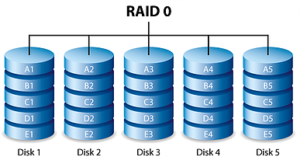
RAID 0 is also known as a stripe set or striped volume because the data is split into ‘stripes’ and saved to the drives simultaneously. This effectively makes the array very quick as reading and writing times are divided by the number of drives used, so if the RAID 0 has 4 drives for example, the array will be almost 4 time quicker than a single drive. However as data is literally split between the drives if one single drive in the array fails, then the data is lost as a RAID 0 provides no fault tolerance or redundancy. This configuration is typically implemented if speed is the intended goal.
Advantages: Speed
Disadvantages: No redundancy
RAID 1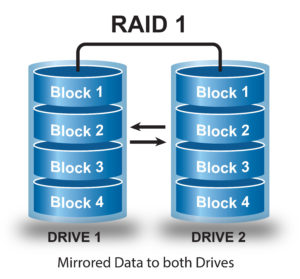
RAID 1 consists of an exact copy (or mirror) of a set of data on two or more disks. A lot of modern NAS systems, such as the Western Digital Duo, can be set up as RAID 0 or RAID 1. This configuration offers no parity or striping across multiple disks and, since the data is mirrored on all disks, the array can only be as big as the smallest member disk. The big advantage is that this array will continue to operate provided at least one member drive is operational.
Advantages: Fault tolerance, redundancy
Disadvantages: Drive number (capacity) limits
RAID 5 (Parity)
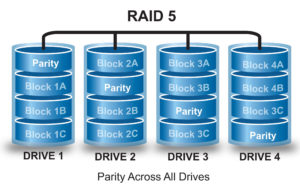 RAID 5 is probably the most common form of array found in small and medium sized businesses. Similar to a RAID 0, the data is split and striped across all drives making the array fast and efficient. However unlike a RAID 0, the array also saves parity data (back up data) on the array. This means that one member disk can fail and the array will continue to work using the distributed parity data from the remaining drives. In the event of a single drive failure, a new drive can be inserted and a rebuild of the array can be completed. The minimum number of disks in a RAID 5 is 3.
RAID 5 is probably the most common form of array found in small and medium sized businesses. Similar to a RAID 0, the data is split and striped across all drives making the array fast and efficient. However unlike a RAID 0, the array also saves parity data (back up data) on the array. This means that one member disk can fail and the array will continue to work using the distributed parity data from the remaining drives. In the event of a single drive failure, a new drive can be inserted and a rebuild of the array can be completed. The minimum number of disks in a RAID 5 is 3.
Advantages: Fault tolerance, redundancy, capacity
Disadvantages: Reduced capacity.
RAID 6 (Parity)
 RAID 6 is very similar to RAID 5 in that data is striped across all drives and parity data is saved allowing for drive failure. However a RAID 6 saves two sets of parity data, therefore two drives are able to fail and the array will continue to work. As in a RAID 5 replacing the failed drives will allow for a full rebuild of the array.
RAID 6 is very similar to RAID 5 in that data is striped across all drives and parity data is saved allowing for drive failure. However a RAID 6 saves two sets of parity data, therefore two drives are able to fail and the array will continue to work. As in a RAID 5 replacing the failed drives will allow for a full rebuild of the array.
Advantages: Fault tolerance, redundancy
Disadvantages: Significantly reduced capacity
RAID 10 (Striped/Mirrored)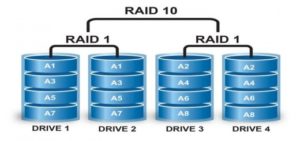
RAID 10 is also referred to as RAID 1+0. This array uses a mix of RAID 0 (speed) with RAID 1 (mirror) to give a relatively fast and redundant array to achieve both replication and sharing of data between disks. At least four disks are required in a standard RAID 01 configuration, but larger arrays are also used.
RAID 50 (Parity/Striped)
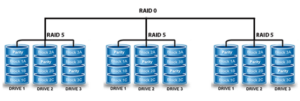 RAID 50 is also referred to as RAID 5+0. The array combines the block-level striping of RAID 0 with the distributed parity of RAID 5. As a RAID 0 array striped across the RAID 5, the minimum RAID 50 configuration is six drives. One drive from each of the RAID 5 could fail without loss of data.
RAID 50 is also referred to as RAID 5+0. The array combines the block-level striping of RAID 0 with the distributed parity of RAID 5. As a RAID 0 array striped across the RAID 5, the minimum RAID 50 configuration is six drives. One drive from each of the RAID 5 could fail without loss of data.
RAID 50 improves upon the performance of RAID 5 particularly during the write cycle. It also provides better fault tolerance than a single RAID level. This level is recommended for applications that require high fault tolerance, capacity and random access performance.
Things to Watch Out For:
There is no doubt that RAID 1, 5 and 6 (and many variances) are great for businesses, but business owners should not be complacent about checking their RAID Array on a regular basis. Remember that if one drive fails in a RAID 5, the RAID will continue to operate normally giving you a false sense of security that there is nothing wrong. It’s only when a second drive fails that the problem becomes apparent and the data cannot be accessed.
When a RAID array is built, it is likely that the drives were purchased at the same time and from the same manufacturer so, if one drive fails for any reason, it’s quite possible that the other drives in the array may be susceptible to failure around the same time.


